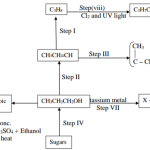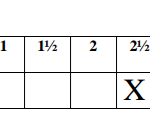KNEC KCSE Chemistry Paper 2 Question Paper / 2016 KCSE KAMDARA JET Examination
2016 KCSE KAMDARA JET Examination
Chemistry Paper 2
The grid below represents part of the periodic table. Study it and answer the questions that
follow. The letters do not represent the actual symbols of the element.
a) What name is given to the group of elements to which Q and R belong? (1 mark)
b) Write the formula of the compound formed when Q and P combine. (1 mark)
c) Name the type of bond formed in (b) above. (1 mark)
d) How does the atomic radii of O and P compare? Give a reason. (2 marks)
e) Draw a dot (.) and cross (x) diagram for the compound formed between N and F. (1 mark)
f) Explain how you would obtain a pure sample of the carbonate of K from its mixture
with Lead carbonate powder. (2 marks)
g) Give one use of element M. (1 mark)
h) The melting point of M is -189oC lower than that of F -102oC. Explain this difference in
their melting points. (2 marks)
11 marks
The list below shows the formulae of some organic compounds. Use letters T1 to T6 to answer the
questions that follow.
T1 – CH3CH2CH2CH2CH3
T2 – CH3CH2CH2COOC2H5
T3 – CH3CH2CH2CH2OH
T4 – CH3CH2CH2COOH
T5 – CH3CH2CHCH2
T6 – CH3CCCH3
(a)Select two compounds which:
(i)Are not hydrocarbons (1mk)
(ii)Would decolourise both bromine water and acidified potassium manganite (VII) (1mk)
(iii)Would produce hydrogen gas when reacted with potassium metal (1mk)
(b) Select a compound which would produce bubbles of a gas when reacted with sodium carbonate.(1mk)
(c) (i)Identify the compound that is likely to undergo polymerization. Give a reason for your answer.
Using two molecules show how polymerization occurs.
I. Compound (1mk)
II. Reasons (1mk)
III. Polymerization (1mk)
(iv)Name the process by which compound T2 is formed and identify the compounds that were used to form
it.
I. Process (1mk)
II.Compounds (1mk)
(i)
(ii)
(d) Compound T3 can be converted to T4 as shown by the equation below:
C4H9OH(l) + O2 (g) C3H7COOH(aq) + H2O(l)
Given the following information:
ΔHc for C4H9OH = – 4910 kJ/mol
ΔHc for C3H7COOH = – 4090 kJ/mol
Determine the heat change for the reaction above.
11 marks
a) What is meant by the term molar enthalpy of combustion? (1mks)
b) The enthalpies of combustion of carbon, hydrogen and ethanol are given below.
C(s)+ O2 (g) → CO2 (g) ∆ H = -393kJmol-1
H2 (g) + ½ O(g) → H2O(l) ∆H = – 286 kJmol-1
Enthalpy of combustion of ethanol ∆H = -1369kJ/ mol
i) Draw an energy cycle diagram that links the enthalpy of formation of ethanol to
enthalpies of combustion of Carbon, hydrogen and ethanol. (3 marks)
ii) Determine the enthalpy of formation of ethanol (1 marks)
c) An experiment was carried out where different volumes of dilute nitric acid (v) acid and aqueous potassium hydroxide both at 25oC were mixed and stirred with a thermometer.
The highest temperature reached by each mixture was recorded in the table below.
| Volume of nitric (V) acid (cm3) | 4 | 8 | 12 | 16 | 20 | 24 | 28 | 32 | 36 |
| Volume of potassium hydroxide cm3 | 36 | 32 | 28 | 24 | 20 | 16 | 12 | 8 | 4 |
| Highest temperature of mixture | 19.8 | 22.2 | 24.6 | 27.0 | 27.0 | 27.0 | 25.0 | 21.0 | 19.0 |
Plot a graph of highest temperature (vertical axis) against volume of nitric acid. (horizontal
axis) 3mks
i) highest temperature reached ( ½ marks)
ii) The volume of the acid that reacted when the highest temperature is reached.
( ½ marks)
iii) The amount of heat liberated during the neutralization process
(Specific heat capacity is 4.2jg-1K-1 and the density of solution is 1.0gcm-3 (2 marks)
d) The molar enthalpies of neutralization for dilute hydrochloric acid and dilute nitric (v) acid are –
55 KJmol-1.while that of ethanoic acid is -52.2kJ/mol. Explain this observation. (2 mks)
11 marks
Experiment was set as shown below.
(a)What is observed on the bulb when the switch is closed? (1mk)
(b)Which electrode will be cathode? (1mk)
(c)Write down the half-cell equations for:
(i)Copper electrode. (1mk)
(ii)Zinc electrode. (1mk)
(d) Write the overall ionic equation for the electrochemical cell. (1mk)
(e)The table below shows the electrode potentials.
| Cu2+(aq) + 2e- Cu(s) E θ = + 0.34V |
| Zn2+ (aq) + 2e- Zn(s) E θ = – 0.76V |
What is the value of the voltage of the cell? (2mks)
(f)The switch is kept closed. State and explain the observation expected after sometime on the
(i)The zinc rod. (2mks)
(ii)Copper (II)Sulphate solution. (2mks)
11 marks
The chart below represents the extraction of iron and some of its uses.
(a)Name the raw materials fed into the blast furnace. (2mks)
(b)Name 3 exhaust gases emitted from the blast furnace. (1½mks)
(c)(i)Why is it necessary to convert pig iron into wrought iron (1mk)
(ii)State one commercial use of iron. (1mk)
(d)Name substances
A (2½mks)
B
C
X
Y
(e)Write equations for reactions in steps
(i)II
III (2mks)
(ii)Write an ionic equation for the reaction in step I. (1mk)
(iii)What observations are made in steps? (2mks)
I
II
11 marks
Study the flow chart below and answer the questions that follow.
a) Name Gas M (1 mark)
b) Name solution F and solid X (1 mark)
Solution F – __________________________________
Solid X – ____________________________________
c) Name the product L formed and give one of its uses (2 marks)
Product L – ______________________________
Use – _________________________________________
d) Write equation of the reaction in the; (2 mark)
i) tower P -____________________
ii) chamber K – _______________________________
e) Name two raw materials required in the manufacture of Sodium carbonate (2 marks)
f) Write an equation of the reaction when solid x is heated. (1 mark)
11 marks
The table below shows the volume of nitrogen (IV) Oxide produced when different volumes of
1M Nitric (V)acid – were each reacted with 4.14g of lead at room temperature.
| Volume of 1 M Nitric (V) acid (cm3) | Volume of Nitrogen (IV) oxide gas (cm3) |
| 10 | 120 |
| 30 | 360 |
| 50 | 600 |
| 70 | 840 |
| 90 | 960 |
| 110 | 960 |
(a)Explain how the rate of the reaction between lead and nitric (V) acid would be affected if the
temperature of the reaction mixture was lowered. (1mks)
(b)On the grid provided below plot a graph of the volume of the gas produced (vertical axis) against
volume of acid. (3mks)
(c) Using the graph, determine the volume of
(i) Nitrogen (IV) oxide produced when 60cm3 of 1M Nitric (V) acid were reacted with 4.14g of lead. (1mk)
(ii) 1M Nitric (V) acid which would react completely with 4.14g of lead. (1mk)
(d) Using the answer in d(ii)above, determine
(i) The volume of 1M Nitric (V) acid that would react completely with one mole of lead. (Pb = 207).(2mks)
(e) Calculate the number of moles of
(i) 1M Nitric (IV) acid reacted with one mole of lead. (1mk)
(ii) Nitrogen (IV) oxide produced when one mole of lead were reacted with excess nitric acid. (Molar gas volume is 24000cm3). (1mk)
(f) Using the answers obtained in e(i) and e(ii) above; write the equation for the reaction between lead and nitric (V) acid given that one mole of lead (II) nitrate and two moles of water were produced. (1mk)
(g) Give a reason why nitric (V) acid is stored in dark bottles. (1mk)
11 marks










dhzd